Art & Design
Art 2900 | Sophomore Portfolio Review
|
|
|
|
Below are descriptions, suggestions, recommendations and warnings about Harding's Art & Design Sophomore Portfolio Review process. (SPR)
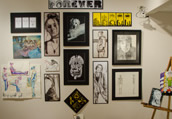 |
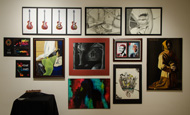 |
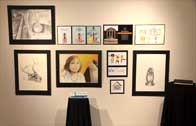 |
 |
Who is reviewed? When do I take the SPR?
What are the possible outcomes or grades?
How do I get ready for the SPR?
What actually happens? Just what IS the SPR?
What do the exhibits look like? How do I present my work?
What's the point of the SPR? What are the reviewers looking for?
Who participates in Art 2900 - Sophomore Portfolio Review (SPR)?
All art and design majors who have completed 12 hours of core Art & Design requirements.
When do I take it?
According to the University catalog...after 12 hours of studio art courses.
Usually during your 3rd or 4th semester you'll take Art 2900/SPR...thus, before you're done with your Sophomore year.
What about transfer students?
Transfer students who have completed 12 or more hours of studio art by the end of their first semester at Harding, will complete their SPR during their second semester at Harding.
All other transfer students will take Art 2900/SPR at the normal time -- as soon as they have completed 12 hours of art.
What courses should I have completed before I take the SPR?
You should have completed most or all of these courses:
Art 1030 - Drawing and Composition
Art 1050 - Drawing and Human Anatomy
Art 1600 - Design Foundations 1
and
Art 2600 - Design Foundations 2
If you're a fine art or art education major, you should have completed, or be taking
Art 3040 - Painting I
or
Art 3000 - Watercolor
If you're a graphic design major, you should have completed or be taking both
Art 3490 - Graphic Design I
and
Art 2200 - Design Software & Production 1.
Interior Design students have somewhat different requirements and schedule, so be sure to check with your IDA advisor.
When in doubt, contact your academic advisor about when to take the SPR.
Register for Art 2900 - Sophomore Portfolio Review
This is a zero-credit, zero-tuition course that is required for graduation for Art & Design degrees.
This course is offered in both Fall and Spring semesters. Interior Design and Architecture students participate in SPR in the Spring semester only.
Discuss with your academic advisor if this is the correct semester to register for Art 2900.
Note: you may be able to register for this course after the usual first-week course enrollment period. Contact your advisor if you need to sign up late for Art 2900.
OnLine Sign-Up List for SPR Presentation Times and Scholarship Application
Sign up for a specific 15 minute time period on the first open presentation day. This is your tentative SPR presentation time.
Sign up for early periods first -- if early periods are left open, those who sign up for later times may be moved up to earlier times.
Indicate if you are applying for a scholarship when you sign up for SPR. Then complete the online Art & Design Scholarship Application Form.
If the posted presentation days are fully booked, sign up on the wait list at the bottom of the page. We'll contact you if we add days or if a time slot opens.
Note that your actual presentaton time or day may be revised by the SPR instructor as needed to distribute presentation times and other scheduling priorities.
If you have any trouble accessing or using the online signup, contact Greg Clayton.
What happens if I don't take it?
Passing the SPR is required for graduation for all Art & Design majors. Thus, the Registrar will not approve your degree without passing SPR.
You cannot register for upper level courses in Art & Design unless you have successfully completed your SPR. Several of your upper level studio classes have Art 2900/SPR as a prerequisite. You either have to have passed SPR, or will need to request a registration override in order to sign up for such courses. These Pre-req registration overrides are at the judgement of the instructor, and thus will not always be granted.
What are the possible outcomes?
There are, officially, several "grades"...
Passed — Unanimous.
—Every reviewing professor agreed on a pure "Passed" status, with no significant weakness needing attention.Passed
— Most of the reviewing professors agreed on a "Passed" status, but some noted weaknesses that need attention.Passed with Minor Weaknesses
— Consensus among reviewing professors was that you passed the SPR, but there are minor issues that need to be improved or addressed if you are to be successful as a degree candidate and as a professional. The SPR Summary will include a description of whatever those issues are.Passed with Major Weaknesses
— Consensus among the reviewing professors was that you passed the SPR, but there are major issues that need to be improved or addressed if you are to be successful as a degree candidate and as a professional. The SPR Summary will include a description of whatever those issues are.Did not Pass
— Consensus among the reviewing professors was that you've not yet demonstrated the basics skills and knowledge necessary to successfully progress into your upper level coursework. Weaknesses and concerns will be listed in your SPR Summary. Unless there are outstanding concerns, you will be invited to take the SPR one more time during the following semester.
How and when do I find out how I did?
Within a couple of weeks of completing the SPR you will get an SPR Summary Report which will summarize the results from your review.The SPR Summary will include the written comments and recommendations from the reviewing professors.
This summary will usually arrive as a letter and/or an email from the head of the department, the head of your major, or your advisor.
A general summary of comments and grading will be included.
What am I evaluated on?
There are several categories on which your presentation is evaluated.Conceptual Thinking:
How evident and developed are the concepts of your works? How in depth or challenging is the content of your works? Basically, have you found a way to say something through your work, expressing a point of view visually?
Note that your sophomore work will include a variety of assignments that are exercisess in drawing, design and basic skllls. These assignments often offer little opportunity for depth of content or concept. You should select some works for your SPR presentation that do present thoughtful approaches to content and concept. We also look through your sketchbooks for evidence of the ideas and concerns that interest you.Design & Compostion:
Are your designs composed and organized well? How successfully do you balance compositions, develop value patterns, establish focal areas and relief areas? In short, are you developing insight into how to organize visual form for viewer impact?
How thoughtfully organized is your presentation -- how successfully composed is the work on the wall? Remember that your presentation itself is a visual composition.Hand Skill and/or Computer Skills
Are you developing solid drawing and perceptual skills? Are basic skills such as value-control, line control, linear perspective, etc. demonstrated?
If you work with graphics software, are demonstrating competency with the basic skills of pen tools, layers, transparency, compositing, color controls, etc.?Verbal & Professional Presentation
How do you present yourself while you present and discuss your work? Do you present a confidence in yourself and your work, and also a humility about limitations and weakness? Are you comfortable talking to a group so that you can be heard and understood? Can you explain your goals and priorities? Can you explain the strenghths, weaknesses and objectives of the work you have presented?
Though you may see yourself as a visual artist or designer, professional practice in art, design or education involves a lot of personal interaction as well.Overall Quality Grade
This is simply an average of the prior four concerns.Pass/Fail Ranking
Each reviewer assessed the works and presentation as a whole and, in effect, gives a grade. The actual grade presented is an average of the reviewers' rankings.
For details, see "What are the possible outcomes?" section, above.
What happens if I really blow it?
a) Find out from your advisor and/or the head of your program what the major concerns were. Identify what you need to improve.
b) Work really hard to develop stronger work.
Get help if needed to build your missing skills, to design more effective and thoughtful works or to select and present your work more effectively. In short, discipline your work and your attention to develop stronger, more complete and more resolved creative work.
If needed, retake courses in which you did poorly.
Then take the SPR again next semester with strong work and a thoughtful presentation.
c) And, if necessary, consider whether you're destined for a career in art & design.
Talk with your advisor and/or the head of your program for feedback and advice.
Collect 12-15 works that demonstrate your foundation drawing & design skills, as well as examples of technical skills appropriate for your major (e.g. computer graphics (Illustrator, Photoshop), oil painting, ceramics).
— Some work from each of studio class you have taken so far.
—A Self-Identifying Sign or Label for your exhibit. Include a sign that tells everyone that this is your work. Remember that your SPR presentation is a small, short exhibit. Your work may be on the wall for a few days or a week, but while it is up, viewers want to know whose work it is.
Design a piece that represents or brands you and your work. You might you a variation on your business card design. In 2D Design you did a self-identifying mark at the beginning of the semester. You might use that as your sign or as the basis for a sign.
It does not have to be elaborate, but it does need to clearly and unambiguously declare whose work is pressented here. Ideally, the sign expresses who you distinctly are graphically.
Most students have had one or more assignments/projects involving a logo, a self-identiyfing mark, a name plate or similar. Feel free to use or revise one of these.
—A brief Artist Statement. Include a small sign or plaque that briefly expresses your approach to creative visual design and expression. You might discuss what motivates you or inspires you. You might describe what you aim for when you design or create. You might describe a process that leads you from blank page to finished work. (usually 25 - 125 words)
— Sketchbooks. Absolutely include one or more sketchbooks of your creative work, your visual rambling, your expressive exploring.
We want to see how you develop ideas, how you explore ideas, and how freely you think visually and conceptually. Sketchbooks are always a good measure of a creative person's working process.
If there are pages in your sketchbook that you really don't want to share, feel free to tape or bind them closed -- we'll respect that. For many of us, sketchbooks are just a sort of visual diary. You're not expected to expose everything you have explored, but we do want to see examples of what and how you have explored visual form.
— Works that demonstrate essential, basic skills — drawing, perspective, anatomy, composition, color use.
Be sure you have at least one piece that demonstrates competency with linear perspective.
If you are a graphic designer, show basic skills with computer-based design tools — specifically, Photoshop, Illustrator and, to a lessor extent, InDesign.
— Works that demonstrate your most advanced skills. Show us examples of what you are now capable of. We know that not all of your work demonstrates your latest skills, but some works should.
— Works that demonstrate your ability to express and deal with complex concepts. A few of your more advanced projects should deal with content that is, itself, challenging to represent or express.
— Works that demonstrate Diversity: show us your range of media. If you've got 3d works (ceramics, sculpture, jewelry, etc.), include some. If you've taken painting, include at least a couple of paintings. Works that demonstrate diversity of skills and media. If you've done some strong photography, include a couple of prints. Show us a bit of any medium that you've begun to conquer.
— Demonstrate Presentation Skills:
Be sure to have works that you've matted and/or mounted for presentation.
Make your your presentation is well planned as a whole. How you arrange your works, is, itself a composition. So, we're interested not just in the quality of your works, but in the quality of your presentation.
You might include works that you did utterly on your own, with no teacher looking over your shoulder.
We like to see what you make that is utterly yours.
Can I include work that wasn't done as a part of a class?
Yes.
Any work that demonstrates skills you have developed, concepts you have conquered, or design/communication/expressive problems you have solved is a candidate for inclusion.
How many finished works should I include? (see examples below)
12-15 is recommended.
Enough to demonstrate your range and depth of skills.
Not too many to survey in a short time. Aim to demonstrate quality and depth, rather than quantity.
Be sure to include at least one of your sketchbooks.
How should my works be presented? ...matted? ...framed? (see examples below)
Several works should be matted. Not all have to be.
All works should be "presentation-ready" -- typically this means that all 2D works are either matted or mounted (on foamcore, mattboard or presentation board).
Ideally all works are presented well, but be sure that:
a) you have some examples of properly matted or mounted works and
b) that all works are thoughtfully prepared for presentation.
Check out the notes, above, under Who is Reviewed, and When?
Bring your works to campus so you have them for the SPR.
If you live a long way from Searcy and you have strong pieces that you know might be presented in your SPR, be sure to plan ahead before the semester begins. Bring key works with you so you don't have to return home or ship them from home before the SPR.
Watch for announcements about SPR.
It doesn't happen at precisely the same time each semester. Usually SPRs occur between the 8th and 12th weeks of the semester. However, the Interior Design program has SPR early in the Spring semester.
Check with your academic advisor.
Sign up to participate — get a time.
Beginning in Fall of 2020, you must sign up for Art 2900 - Sophomore Portoflio Review.
You'll sign up for a particular day, and a particular presentation time.
You sign up for a 15 minute time slot during which you'll answer questions and discuss your work, your direction and your development as an artist/designer. . (see What actually happens?, below)
SPR usually occurs between 4pm and 6pm. The days vary, but Tuesday or Thursday are common.
Sign up as soon as you can. Sometimes the schedule fills quickly and ideal times that fit your work schedule are taken.
If you need to sign up for upper level art courses for next semester, you must be sure to complete the SPR this semester — sign up quickly so you don't get bumped to the next semester due to a filled SPR schedule.
Come to the SPR Orientation/Information Sessions
In most semesters, there will be an afternoon session designed to introduce you to the SPR, the process and the preparations. Typically we do this on a Tuesday at 4pm in room Art 201. Watch for emails or Canvas messages announcing these sessions.
These sessions involve faculty and/or upper level art/design students explaining the SPR.
Come to the session. Bring works if you want your artwork reviews. Ask your questions and get good, practical advice.
Collect, select, finish and refine your art and design samples.
Ideally, collect more work than you need, then cull the works down to the essential best works.
Feel free to get feedback from an upperclassman artist/designers, or from one of the professors. We're happy to help.
You want the best works that demonstrate a wide range of abilities — not everything; only the best.
And you do want to present each work at its best....right?
If its not finished, consider taking time to finish it.
If its not printed well, reprint it.
If is not trimmed, mounted or matted well, do that.
Revise weak projects
If you know a project needs to be changed or revised, and the medium allows it, do so.
This is particularly true for digital designs. Anything you created in Illustrator or Photoshop can be revised and reprinted — don't assume that the version you turned in for a grade is what you must show in the SPR. (you might even bring the "before" version as well as the "after")
Show us the best you are capable of at this time.
Plan your exhibit — arrange your works as a designed composition. (see examples below)
Create an arrangement that composes your works for best effect. Always remember that you are an artist/designer and so every aspect of presentation is open to scrutiny. Your exhibit is a composition in itself. Arrange your works as a unified whole.
Consider major focal pieces and lesser supporting works — arrange your works for graphic impact and for hierarchy.
Consider alignment and spacing between your works.
Consider the overall shape or bounding contour of your works.
Consider viewing height. Note, however, that simply due to the small space available, some works will necessarily be higher or lower than ideal — just avoid awkward extremes.
Hang your mini-exhibit in the gallery: (see examples below)
A few days before the SPR, you will have a space assigned to you in the Art Gallery. Usually you'll have at least an 8' wide portion of a gallery wall.
You'll have times when the gallery is open for hanging or arranging your works.
Some basic supplies (nails/hooks, hammers) will be available to you in the gallery kit kept in the gallery store room.
Hanging Guidelines:
• Minimize the number of holes you leave in the wall by using one hanger on the backs of your work instead of the "L" nails. See the gallery coordinator for the "how to" on methods of hanging matted and unmated pieces of art.
• Use the smallest nails that you can get by with. Do not use screws, without checking with the gallery coordinator to see if they are appropriate.
• Do NOT use double stick adhesive strips, or double-stick tapes that do not say "removable" on the packaging.
• Do NOT draw on the walls with a pen or pencil.
You're NOT required to put labels on your works.
Dress for Success
Be dressed as you would for a job interview. (for a job you really want)
Look your best and be yourself -- represent yourself as a promising artist/designer by how you design and present your own appearance.
Like it or not, we are judged, in part, by how we present ourselves.
Arrive at the Art Gallery at least 15 minutes ahead of your scheduled time.
(why? Sometimes someone else cancels or is sick ... then you'll be moved up in the schedule. On days like this, its not good to keep the interviewer's waiting. )
Wait outside the gallery in the lobby or the hall. There is seating out there.
Please don't sit where you can see into the gallery while someone else is presenting -- they're likely nervous enough already.
You'll be called into the gallery around the time you're scheduled to present. (see What actually happens?, below)
Be aware that sometimes the reviews run long and so our schedule runs late.
The presenters scheduled for the later presentation times may have to wait beyond their scheduled time.
Check the signup sheet for take down times -- in some cases, you can take work down later the same evening, in other cases take-down will begin in a day or two.
Do note the latest take down time -- when your work must be off the walls and out of the gallery.
When pulling nails out of the wall, have a piece of matt board or foam core under the hammer head to protect the wall from dents and scuffs.
Andy Warhol claimed that in the future, everyone would have 15 minutes of fame.
(and that was 40 years before reality TV and blogs)
In your SPR, you have 15 minutes of scrutiny.
Here's how it goes.
At your appointed time, you'll be invited into the gallery where you've hung your works.
Your professors will be waiting for you, sitting near your exhibited works.
They may be looking over your sketchbooks or examining whats on display.
You don't need to say or do anything until prompted.
Just stand to one side of your works...
...and breath.
You'll likely be invited to introduce yourself — give your name, your major, what year you are (Sophomore, Junior, etc.).
You might be asked to describe your career goals — "What would you like to be doing after you graduate?" "What is the ideal job that you are training for?"
You don't really have to plan a formal verbal presentation of your work.
Just wait for questions and respond.
Your professors will ask questions about your work and your progress... and about other aspects of your goals, methods and influences.
There is no one set of questions that you'll have to respond to. Every SPR is a bit different, with subsequent questions flowing from your initial responses.
Its just a conversation about your work, your progress and your direction... maybe its an intimidating conversation, but really its nothing more.Questions from the past include...
"Which are your strongest pieces.... and why?"
"Which are your weakest pieces... and why? What might you change about them if you were revising that piece?"
"Tell us how you developed your concept for that piece."
"Why did you include that piece? What skills or strengths does it demonstrate?"
"Who is your favorite artist/designer...and why?"
"What artist/designer has influenced your creative work more than any other...and how? Which of your works show that influence?"
"Which piece best demonstrates who you are as an artist/designer? ...which demonstrates your unique point of view and/or style?"
"Which piece involved the most conceptual exploration and planning? Which piece expresses the most difficult content?"
"How do you keep up with current art and design? What art/design journals or blogs do you read regularly? What museums or galleries have you visited in the past year?"
As your time winds down, you might be asked if you have questions for us -- for your professors.
Feel free to ask whatever you like. We'll decide whether and how to answer.
After that, you'll be invited out... you're then free to escape the gallery and breath a well-deserved sigh of relief.
You did it!
After your SPR — note the take-down deadline.
You should get a message telling you that its time to take your work down.
Sometimes this will occur the day following your SPR.
Sometimes it will be several days later.
It just depends on gallery scheduling issues.
The department office manager should be able to tell you when your work must come down.
When removing your work from the gallery you are expected to return any supplies or bases to the gallery storage room.
Any nail holes you made in the wall need to be filled with spackle. (Jars of spackle should be in the gallery store room for your use.)
Any significant marks or repairs will need to be painted. (just paint the problem area.... not the whole wall. The gallery kit will have some small brushes, a small can/jar of the correct paint. The paint is latex — so clean and rinse the brush with water thoroughly before returning it. The nearby restrooms, of course, have faucets.)
You'll have a space in one of the galleries that is about 10 feet wide. You'll arrange and hang your works in that space.
The gallery kit will be available to you. It will have nails and hammers. There is a selection of bases and stands in the gallery storeroom for 3D works, along with black drapes, if wanted, to cover the bases.
Give attention to arrangement and spacing.
You can arrange spotlights that are near your display space. Get a ladder from the storeroom along with a friend to hold the ladder steady. Report any burned out bulbs to the art office. AND be careful of hot light fixtures — once lights have been turned on for a few minutes, they heat up and can burn you. To adjust lights, use a cloth or gloves. Ask if you aren't sure how to adjust the lights — some of the track lights have release mechanisms that are not obvious.
 |
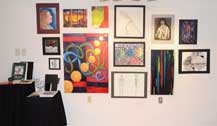 |
 |
 |
|
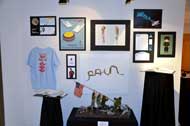 |
 |
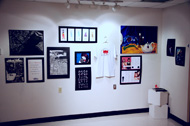 |
 |
What are the professors really looking for? What's the point of the review?
First, this is not an "Are you ready for graduation and professional practice?" portfolio review.
That comes just before you graduate.
Not now.
Relax.This is a "How are you doing building your basic skills, competencies and creative process?" review.
We want to know: Are you laying your foundation of basic visual design skills?
We want to see that you are taking your own growth and development as an artist and designer seriously.
We will be looking for evidence of your basic skills, plus evidence that you are beginning to develop your distinctive personal strengths, talents and imagery.
Basic skills include drawing and visualization skills — basic line control, perception of proportion and shape, value-discernment and control.
We'll look for evidence of an understanding of linear perspective and other aspects of spatial representation.
We look for evidence of competency with human anatomy, particularly aspects such as proportion, value-modeling and foreshortening.
We'll look for evidence of compositional awareness and planning — are your compositions balanced, are focal are relief areas developed, is graphic hierarchy developed, are compositions unified using similar or related forms? Is there adequate variety, contrast and dynamism to maintain visual interest?
Have you selected and applied color effectively for the sake of expression and for the sake of harmony?
If your studio art & design grades have been strong and you select your works well for presentation, and you also arrange and discuss your work well, you should do fine.
We want to know: Are you starting to develop a unique point of view and a distinctive direction?
One common problem is this: sometimes students manage to do fairly well on individual class projects, but do not develop depth or a consistent direction in their creative work.
Art and Design are creative professions in which there is no simple recipe for success. You must build your personal imagery, your own expressive language and define your own professional direction. These things are aided by structured courses, but cannot be forced or formulated into being. Ideally, you are using each course project as an opportunity to test and demonstrate your own unique personal vision through imagery and form. Class assignments can be a framework for you to explore and expand your expressive range.
In the SPR, we want to see whether you are doing that, or whether you are just repeatedly turning in competent projects defined entirely by the assignment, with little vision or thoughtfullness on your part.So, in part, we want to confirm that you are developing a creative direction, and that you are using your time in college to develop it.
The works you present in your SPR are the evidence.
During most school years the Department of Art & Design offers scholarships for Junior and Senior Art & Design majors.
The amount of funds offered varies, but may be up to $1000 per academic year.
Actual amounts depend on availability of funds and the number and strength of applicants.A part of the scholarship selection process is the Sophomore Portfolio Review. The strength and depth of work presented, as well as the creative maturity and professional promise of the applicant are considered by the faculty.
In order to apply for a scholarship:
a) Indicate that you are applying when you sign up for your SPR presentation time. The online SDR signup form includes a scholarship applicant field on the right side.
b) Develop and present a strong portfolio of work that includes pieces that demonstrate your creative direction, strong concepts, and maturing craft. Be able to discuss your influences and goals as an artist or designer. This is expected of all SPR presenters, but it will also influence scholarship consideration.
c) Be sure your overall GPA is above 3.0, and your Art & Design GPA is above 3.5.
d) Complete the scholarship application form posted online. Complete it prior to your SPR presentation.
|